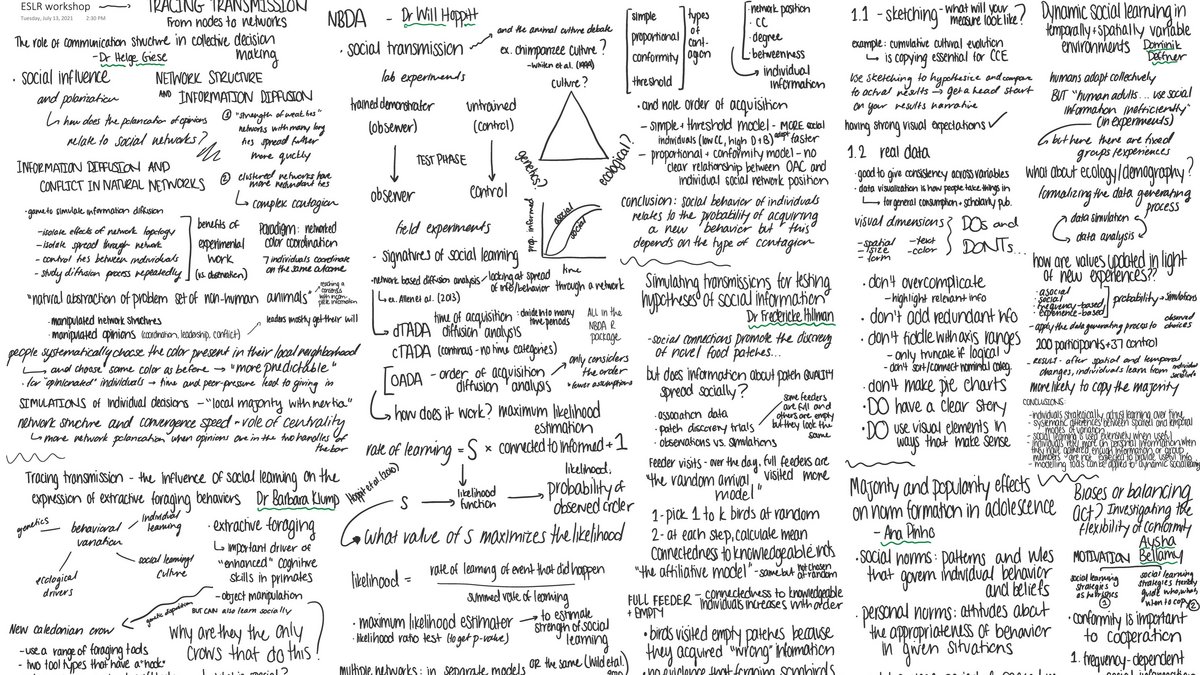
4th Annual ESLR Workshop
Tracing Transmission From Nodes to Networks
Sonja Wild and Michael Chimento organized the virtual workshop Tracing Transmission – from Nodes to Networks within the Association of Early-career Social Learning Researchers (ESLR). They provided some insight into the event and their experience of bringing people together online.
You organized a four-day workshop on Tracing Transmission – from Nodes to Networks. What is it about this topic that interests you?
Sonja My entire career so far has focused on questions revolving around drivers that lead to behavioural diversity and the emergence of culture in wild animal populations. Behavioural patterns in wild animals can be challenging to study, but recent advances in technology and the development of novel statistical methods have opened up exciting new avenues to approach these questions. How does the social network shape the transmission of novel behaviour? What learning strategies do individuals employ and why? How do these change throughout an individual’s lifetime and in relation to the environment? And what lessons can we learn from all this for conservation?
Michael My area of research focuses on cultural evolution, or how cultural traits and their distributions change over time. Cultural traits are socially transmitted from individual to individual across association networks, so questions such as when, how and why social transmission occurs between individuals are very relevant for progressing our understanding of why certain cultural traits persist and others die out. Developing models for transmission processes is still an area of active exploration and debate in the field, so organizing a workshop centred on this topic seemed useful, especially for early career researchers who are beginning to apply these methods to their own data.
Concerning collective behaviour – what were the three most relevant outcomes of the workshop?
Michael & Sonja This year’s workshop focused on the theme of social networks. One keystone event was a hands-on workshop on applying Network-Based Diffusion Analysis (NBDA) models, which serve to detect signals of social learning within networks of individuals. NBDA is a popular and powerful tool for detecting and quantifying social learning and for establishing typical pathways of transmission, thereby helping to understand how learning processes can shape behavioural patterns on a population level. During a hands-on and interactive workshop, participants learned to understand the theoretical background of NBDA models and how to implement them.
The second key activity was a workshop on data visualization. In times of automated data collection, researchers often generate large, complex and sometimes high-dimensional data sets, which can be challenging to present to an audience. Participants learned new creative skills related to visualizing and presenting data generated by analyses of social networks and agent-based models. Finally, during the two exciting keynote talks by Dr Helge Giese (CASCB) and Dr Barbara Klump (MPI), and of course the numerous talks and posters from participants, we learned so much about collective behaviour across a wide range of different species and contexts. Did you know that in tits, individuals with higher activity levels are more likely to be the leaders in a social group? Or that in humans, ethnocentrism is highest in conditions of low to moderate threat, while they start cooperating across groups when facing higher levels of threat?
ESLR workshops also aim to bring early career researchers together. What did you implement for virtual networking with the other participants? And how was it
perceived by the participants?
Michael & Sonja The ESLR workshop brought together over 60 participants from 10 different time zones. We chose to host the event on the GatherTown platform, which allows participants to explore a virtual world that we constructed using an avatar and lent a little interactivity and realism beyond what a virtual workshop held strictly over Zoom would offer. We prepared a variety of activities to enable networking among participants. This included an icebreaker, during which we created mind maps to identify overlaps and differences in research interests, and a guided discussion on challenges we face as early career researchers. We provided private and group spaces in the virtual venue to encourage after-hour drinks/chats, and we put up a networking board, on which participants could leave their contact details to stay in touch even after the event. Overall, we believe we have managed to encourage exchange and potential future collaborations among like-minded early career researchers.
What was your highlight when organizing the workshop?
Sonja Organizing a virtual workshop was a huge challenge. My personal highlight was seeing all the content faces – both of the participants and the organizing team – at the end of the workshop week. Finishing the week with a smile on my face after all the hard work we put in felt pretty good!
Michael One highlight for me was designing the venue space in GatherTown. I didn’t want to use the generic templates for rooms and put quite a bit of effort into making the space inviting so that participants would feel comfortable and part of it. Seeing how much participants had enjoyed the workshop was very rewarding.
